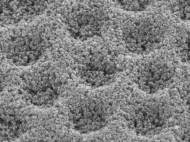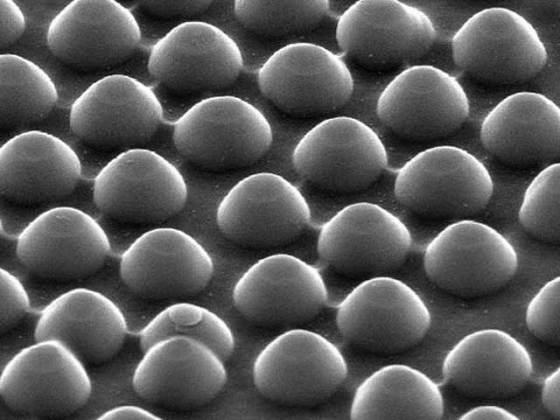Plasmonics with coated nanodomes for thin and affordable solar cells
 A multidisciplinary team of Stanford engineers led by Mike McGehee, Yi Cui and Mark Brongersma, and joined by Michael Graetzel at the École Polytechnique Fédérale de Lausanne (EPFL), is developing a new type of thin solar cell that could offer a new direction for the field. They succeeded in harnessing plasmonics – trapping light within thin solar cells to improve performance and push them one step closer to daily reality.
A multidisciplinary team of Stanford engineers led by Mike McGehee, Yi Cui and Mark Brongersma, and joined by Michael Graetzel at the École Polytechnique Fédérale de Lausanne (EPFL), is developing a new type of thin solar cell that could offer a new direction for the field. They succeeded in harnessing plasmonics – trapping light within thin solar cells to improve performance and push them one step closer to daily reality.
“Plasmonics makes it much easier to improve the efficiency of solar cells”, said McGehee, an associate professor of materials science and engineering at the Stanford University and director of the Center for Advanced Molecular Photovoltaics – a multidisciplinary, multi-university team tackling the challenges of thin-film solar cells.
Plasmonics is the study of the interaction of light and metal. Under precise circumstances, these interactions create a flow of high-frequency, dense electrical waves rather than electron particles. The electronic pulse travels in extremely fast waves of greater and lesser density, like sound through the air.
“Using plasmonics we can absorb the light in thinner films than ever before”, he added. “The thinner the film, the closer the charged particles are to the electrodes. In essence, more electrons can make it to the electrode to become electricity.”
McGehee and team members spread a thin layer of batter on a transparent, electrically conductive base. This batter is mostly titania, a semi-porous metal which is also transparent to light. Next, they use their nano-mould of iron to imprint the dentures which remind of a honey comb. After they make the dentures, they add a layer of a light-sensitive dye which dentures and potential cracks inside the imprint. At the end, they added a layer of silver, which hardens almost immediately. The result is a pattern of nanodomes on the light-ward side of the silver.
This layer of silver acts as a mirror, scattering unabsorbed light back into the dye for another shot at collection, and it enables the reaction between the light and the silver nanodomes to produce plasmonic effects. According to researchers, the reflectors without them will not produce the desired effect, and the nanodomes must be just the right diameter and height, and spaced according to their findings, to fully optimize the plasmonics.
The photons enter and pass through the transparent base and the titania (the waffle), at which point some photons would be absorbed by the light-sensitive dye (the butter), creating an electric current. Most of the remaining photons would hit the silver back reflector and bounce back into the solar cell. A certain portion of the photons that reach the silver, however, will strike the nanodomes and cause plasmonic waves to course outward.
In recent years, much hope has been directed toward these lightweight, flexible cells that use photosensitive dyes to generate electricity. These cells have many advantages, because they are less energy intensive and less costly to produce. They are thinner even than other “thin” solar cells, and as you probably know, thinness enables higher flexibility. Thus, they are printable on flexible bases that can be rolled up and taken virtually anywhere. Many use non-toxic, abundantly available materials, as well – a huge plus in the push for sustainability.
The downsides of this technology are its efficiency (about 8% of light is converted into electricity), and its durability (about 7 years under continuous use outside). In comparison, the bulkier commercial solar technologies available today have reached 25% efficiency, and certain advanced applications exceeded 40% in efficiency, and the commercial standard is 20 to 30 years of durability.
Nonetheless, the researchers believe that if they can convert just 15 percent of the light into electricity, and increase the lifespan to a decade, we might soon find ourselves in the age of personal solar cells. I must agree that there is no need for expensive and more durable technologies due to progress in that field of technology which would require you to change the solar cells used to power your home once a significantly efficient technology emerges.










Improvement in cost Effective solar cell technology.
Dr.A.Jagadeesh Nellore(AP),India
If understood well, this can improve available solar cells by additional 8 to 15 percent of energy?
Great news for alternative energy generation.